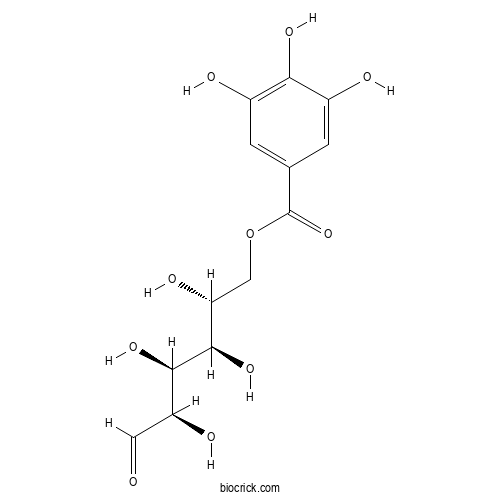6-O-GalloylglucoseCAS# 13186-19-1 |

Quality Control & MSDS
3D structure
Package In Stock
Number of papers citing our products

| Cas No. | 13186-19-1 | SDF | Download SDF |
| PubChem ID | 128839 | Appearance | Powder |
| Formula | C13H16O10 | M.Wt | 332.3 |
| Type of Compound | Phenols | Storage | Desiccate at -20°C |
| Solubility | Soluble in Chloroform,Dichloromethane,Ethyl Acetate,DMSO,Acetone,etc. | ||
| Chemical Name | [(2R,3R,4S,5R)-2,3,4,5-tetrahydroxy-6-oxohexyl] 3,4,5-trihydroxybenzoate | ||
| SMILES | C1=C(C=C(C(=C1O)O)O)C(=O)OCC(C(C(C(C=O)O)O)O)O | ||
| Standard InChIKey | SMZJCCHIPATQCN-LUTQBAROSA-N | ||
| Standard InChI | InChI=1S/C13H16O10/c14-3-8(17)11(20)12(21)9(18)4-23-13(22)5-1-6(15)10(19)7(16)2-5/h1-3,8-9,11-12,15-21H,4H2/t8-,9+,11+,12+/m0/s1 | ||
| General tips | For obtaining a higher solubility , please warm the tube at 37 ℃ and shake it in the ultrasonic bath for a while.Stock solution can be stored below -20℃ for several months. We recommend that you prepare and use the solution on the same day. However, if the test schedule requires, the stock solutions can be prepared in advance, and the stock solution must be sealed and stored below -20℃. In general, the stock solution can be kept for several months. Before use, we recommend that you leave the vial at room temperature for at least an hour before opening it. |
||
| About Packaging | 1. The packaging of the product may be reversed during transportation, cause the high purity compounds to adhere to the neck or cap of the vial.Take the vail out of its packaging and shake gently until the compounds fall to the bottom of the vial. 2. For liquid products, please centrifuge at 500xg to gather the liquid to the bottom of the vial. 3. Try to avoid loss or contamination during the experiment. |
||
| Shipping Condition | Packaging according to customer requirements(5mg, 10mg, 20mg and more). Ship via FedEx, DHL, UPS, EMS or other couriers with RT, or blue ice upon request. | ||

6-O-Galloylglucose Dilution Calculator

6-O-Galloylglucose Molarity Calculator
| 1 mg | 5 mg | 10 mg | 20 mg | 25 mg | |
| 1 mM | 3.0093 mL | 15.0466 mL | 30.0933 mL | 60.1866 mL | 75.2332 mL |
| 5 mM | 0.6019 mL | 3.0093 mL | 6.0187 mL | 12.0373 mL | 15.0466 mL |
| 10 mM | 0.3009 mL | 1.5047 mL | 3.0093 mL | 6.0187 mL | 7.5233 mL |
| 50 mM | 0.0602 mL | 0.3009 mL | 0.6019 mL | 1.2037 mL | 1.5047 mL |
| 100 mM | 0.0301 mL | 0.1505 mL | 0.3009 mL | 0.6019 mL | 0.7523 mL |
| * Note: If you are in the process of experiment, it's necessary to make the dilution ratios of the samples. The dilution data above is only for reference. Normally, it's can get a better solubility within lower of Concentrations. | |||||

Calcutta University

University of Minnesota

University of Maryland School of Medicine

University of Illinois at Chicago

The Ohio State University

University of Zurich

Harvard University

Colorado State University

Auburn University

Yale University

Worcester Polytechnic Institute

Washington State University

Stanford University

University of Leipzig

Universidade da Beira Interior

The Institute of Cancer Research

Heidelberg University

University of Amsterdam

University of Auckland

TsingHua University

The University of Michigan

Miami University

DRURY University

Jilin University

Fudan University

Wuhan University

Sun Yat-sen University

Universite de Paris

Deemed University

Auckland University

The University of Tokyo

Korea University
- Isokaempferide 7-rutinoside
Catalog No.:BCX0109
CAS No.:18467-06-6
- 24-epi-7,8-Didehydrocimigenol 3-xyloside
Catalog No.:BCX0108
CAS No.:150972-77-3
- 2-Glucosyloxy-4-methoxycinnamic acid (Z-GMCA)
Catalog No.:BCX0107
CAS No.:31564-49-5
- 4-(2-Hydroxyethyl)benzoic acid
Catalog No.:BCX0106
CAS No.:46112-46-3
- N-trans-p-Coumaroyl-N'-trans-feruloyl-3-hydroxy-cadaverine
Catalog No.:BCX0105
CAS No.:2584997-91-9
- (Z)-Tonghaosu
Catalog No.:BCX0104
CAS No.:4575-53-5
- cis-2-Hydroxy 4-methoxycinnamic acid 2-glucoside
Catalog No.:BCX0103
CAS No.:150892-86-7
- alpha-[4-[(1E)-2-Carboxyethenyl]-2-hydroxyphenoxy]-beta,3,4-trihydroxybenzenepropanoic acid
Catalog No.:BCX0102
CAS No.:285136-03-0
- 1-Methyl-6,8-dimethoxyquinoline-2 1H-one
Catalog No.:BCX0101
CAS No.:1210820-67-9
- Raddeanoside R9
Catalog No.:BCX0100
CAS No.:124961-62-2
- (E)-Tonghaosu
Catalog No.:BCX0099
CAS No.:50257-98-2
- Quercetagetin 3-methyl ether 7-glucoside
Catalog No.:BCX0098
CAS No.:76060-29-2
- Neobudofficide
Catalog No.:BCX0111
CAS No.:194602-91-0
- Sequoiaflavone
Catalog No.:BCX0112
CAS No.:21763-71-3
- (2R)-3-Hydroxy-2-[4-(3-hydroxypropyl)-2- methoxyphenoxy]propyl beta-D-glucopyranoside
Catalog No.:BCX0113
CAS No.:198817-97-9
- Obacunonic acid
Catalog No.:BCX0114
CAS No.:1961237-40-0
- Guaiacylglycerol 8-O-beta-D-glucopyranoside
Catalog No.:BCX0115
CAS No.:109280-40-2
- Cristatein
Catalog No.:BCX0116
CAS No.:919490-61-2
- (2S)-3-Hydroxy-2-[4-(3-hydroxypropyl)-2- methoxyphenoxy]propyl beta-D-glucopyranoside
Catalog No.:BCX0117
CAS No.:198817-98-0
- Apigenin 7,4'-diglucoside
Catalog No.:BCX0118
CAS No.:31737-50-5
- Methyl obacunoate
Catalog No.:BCX0119
CAS No.:751-48-4
- 2-Methoxyphenyl-4-propylene-1-O-beta-apiofuranosyl-(1-6)-beta-glucopyranoside
Catalog No.:BCX0120
CAS No.:2476709-47-2
- Borapetoside A
Catalog No.:BCX0121
CAS No.:100202-29-7
- Quercetin 3-glucosyl-(1->2)-galactoside
Catalog No.:BCX0122
CAS No.:95043-15-5
Biosynthesis of gallotannins : Enzymatic 'disproportionation' of 1,6-digalloylglucose to 1,2,6-trigalloylglucose and 6-galloylglucose by an acyltransferase from leaves of Rhus typhina L.[Pubmed:24194082]
Planta. 1991 May;184(2):285-9.
Cell-free extracts from leaves of Rhus typhina L. (sumach) were found to transfer the 1-O-galloyl moiety of l,6-di-O-galloyl-beta-D-glucose to the 2-position of the same compound, yielding 1,2,6-tri-O-galloyl-beta-D-glucose and leaving 6-O-Galloylglucose as the deacylated by-product. The enzyme catalyzing this 'disproportionation' was purified almost 1700-fold. It had a molecular weight of approx. 56 000, a K m value of 11.5 mM, was stable between pH 4.5 and 6.5, and most active at pH 5.9 and 40 degrees C. The systematic name "1,6-di-O-galloyl-glucose: 1,6-di-O-galloylglucose 2-O-galloyltransferase" (EC 2.3.1.) was proposed for this new enzyme whose detection provided evidence that, in addition to beta-glucogallin (1-O-galloyl-beta-D-glucose), higher substituted glucose esters also have the potential to serve as acyl donors in the biosynthesis of gallotannins.


